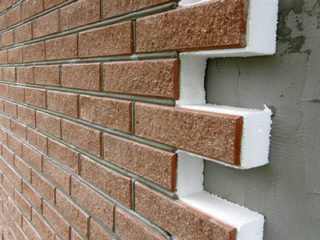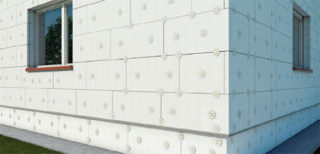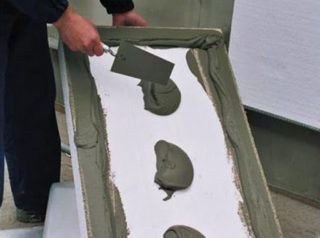Facade foam is an inexpensive thermal insulation material used in private, commercial and civil construction. It is easy to install, does not create a load on the building, has strength and moisture resistance required for exterior decoration. The cost and purpose of the material depends on its brand and density.
Classification of facade foam by production method

Polyfoam or expanded polystyrene (PPS) is a rigid insulating material produced in the form of plates of various densities and thicknesses. The raw material for its manufacture is polystyrene granules, and the foaming agents are low-boiling hydrocarbons and gas-formers. When heated, the granules increase in volume 10-30 times. Carbon dioxide, isopentane, or other reagents foams the polystyrene. As a result, in the finished product, the polymer occupies only 2% of the volume, and the rest is taken up by gas.
According to the method of production, PPP is divided into two types:
- Produced by the sintering method, when, when heated, the granules are sintered together with the simultaneous formation of the product.
- Obtained by foaming from a granular mass to which a blowing agent is added.
Various production methods make it possible to obtain a material similar in composition, but differing in structure (open or closed) and cell density.
Varieties of foam by type of marking

Polyfoam is made by pressing and non-pressing, it has different densities and additives. All information is reflected in the product labeling:
- PS - extruded polystyrene foam has high strength, but due to its high cost, it is rarely used when insulating houses.
- PSB - suspension pressless - the most common type of material used for thermal insulation.
- PSB-S - self-extinguishing suspension pressless - foam with fire retardants introduced during production to reduce the flammability of the plates.
- EPS - extruded polystyrene foam - a material obtained by extrusion - forcing a viscous solution through a molding apparatus. EPS has improved performance and long service life.
The PSB-S marking in other countries has been replaced by the abbreviation EPS, EPS, respectively - XPS. On the building materials market, there are slabs with a foreign designation, so it is worth remembering it.
Types of thickness and density of slabs

Facade polystyrene foam is manufactured in sizes 500 × 1000, 1000 x1000, 1000 × 2000 mm, the manufacturer can make slabs according to the customer's parameters. Material thickness from 20 to 50 mm in increments of 10 mm and 100 mm. When choosing the optimal thickness, the climatic conditions in the region are taken into account. For thermal insulation of facades, plates of 50 mm or more are recommended.
Foam plastic for the facade is of four density grades:
- PSB-S 15 - slabs provide the best thermal insulation, but are not suitable for loaded structures. Their density is 15 kg / m³.
- PSB-S 25 - the parameter 25 kg / m³ includes the facade grades of expanded polystyrene used for all types of vertical structures. Average density is a balanced version of insulation and strength characteristics.
- PSB-S 35 is a reliable and durable material recommended for all construction sites. It can withstand high bending and deformation loads.
- PSB-S 50 - slabs with a density of 50 kg / m³ are installed in industrial and public buildings. They are suitable for insulating a loaded roof, floor, and foundation of a house. This is the most expensive foam.
High density slabs are designed for thermal insulation of industrial facilities, parking lots and roads. Styrofoam on the facade of a low-rise building can have a density of 25 kg / m³.
Pros and cons of insulation

Structural features determine the main advantages of the material. Expanded polystyrene for the facade has many advantages:
- Gas-filled cells provide low thermal conductivity and provide excellent insulation. PPS panels for facade insulation provide an optimal level of energy saving.
- Plates have the ability to absorb noise, protecting the house from extraneous sounds.
- Moisture resistance and low water absorption allow the use of insulation outside the building, including for the foundation and basement.
- Polyfoam is resistant to biological effects, it is not a favorable breeding ground for mold and fungi.
- The compressive strength of the slabs allows them to be used as a reliable base for facade finishing.
- The low weight of the insulation does not give a significant load on the base.
- Expanded polystyrene is easy to process and install, the process of warming a house can be done independently.
- Plates do not deteriorate their properties and do not change their dimensions during operation.
Cons of material:
- Polyfoam without additives of flame retardants is cheaper, but fire hazardous.
- Burning releases toxic substances.
A significant factor for builders choosing foam for facade insulation is its low cost.
Foam facade manufacturing technology

A modern insulation for external walls, polystyrene is mounted using glue mortar and disc dowels. The work takes place in several stages:
- Surface preparation. Before insulating the walls, they must be cleaned and leveled. You will need to remove the remnants of the old coating and dirt. The protrusions on the wall knock off, and the cracks are filled with plaster. The last step of the preparatory work is soil treatment. The solution will prevent the formation of mold and improve adhesion to the adhesive.
- Installation of an ebb or starter bar. Experts recommend installing a galvanized steel ebb between the plinth and the rest of the facade. This part will serve to drain rainwater. You can also screw on a metal starting profile to support the insulation.
- Installation of expanded polystyrene sheets on the facade. Styrofoam is attached to the walls using a diluted adhesive mixture and plastic dowels with an elongated leg and a wide flat head. The solution is prepared by adding water according to the instructions and mixing the composition with a mixer. The glue mixture is applied to the slabs with a spatula. It is distributed around the perimeter and several cakes are made in the central part. The insulation is pressed tightly against the wall. Each sheet is joined to each other. The rows of material are laid with an offset of half the slab.
- Fastening with mushroom dowels. For each sheet of foam, 5 fasteners are consumed, 4 in the corners and one in the center. Holes are drilled under the dowels with a drill. Fasteners are placed at the junction of adjacent slabs. The cap of the fungus is sunk into the insulation by 1 mm.
- Finishing work. The joints of the plates and the attachment points are sealed with the remnants of the adhesive solution. After it dries, the insulation is reinforced with a fiberglass mesh. A layer of glue is applied to the wall, into which the cellular fabric is recessed. From above it is covered with another layer of solution. The corners of the building are formed with a metal perforated corner.
The best option for insulating the facade with expanded polystyrene is plates of the PSB-S 25 F. The material should be white, without foreign odors, with granules of the same size.To create a reliable barrier from the cold, slabs with a thickness of 100 mm are required. Correct installation of polystyrene plays an equally important role.








